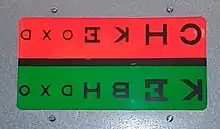Duochrome test
A duochrome test is a test commonly used to refine the final sphere in refraction (undercorrection and overcorrection), which makes use of the longitudinal chromatic aberration of the eye. Because of the chromatic aberration of the eye, the shorter wavelengths (green) are focused in front of the longer red wavelengths.

Testing
The patient is asked to compare the clarity of the letters on the green and the red side. If the letters of the green side are clearer +0.25 D sphere is added and if the letters on the red side are clearer -0.25 D sphere is added. With optimal spherical correction, the letters on the red and green halves of the chart appear equally clear.
Because this test is based on chromatic aberration and not on color discrimination, it is used even with people having color vision deficiency.[1]
The eye with overactive accommodation may still require too much minus sphere in order to balance the red and green. Cycloplegia may be necessary.
The duochrome test is not used with patients whose visual acuity is worse than 20/30 (6/9), because the 0.50 D difference between the two sides is too small to distinguish.
See also
References
- Makgaba, Nkalebetja T.; Mathebula, Solani D. (2020-09-30). "Investigation of the unfused cross cylinder test as an alternative method for the determination of spherical distance refraction end points". African Vision and Eye Health. 79 (1). doi:10.4102/aveh.v79i1.514. ISSN 2410-1516. S2CID 224991918.
- Myron Yanoff, Jay S. Duker (2009). Ophthalmology (3rd ed.). Mosby Elsevier. p. 67. ISBN 9780323043328.